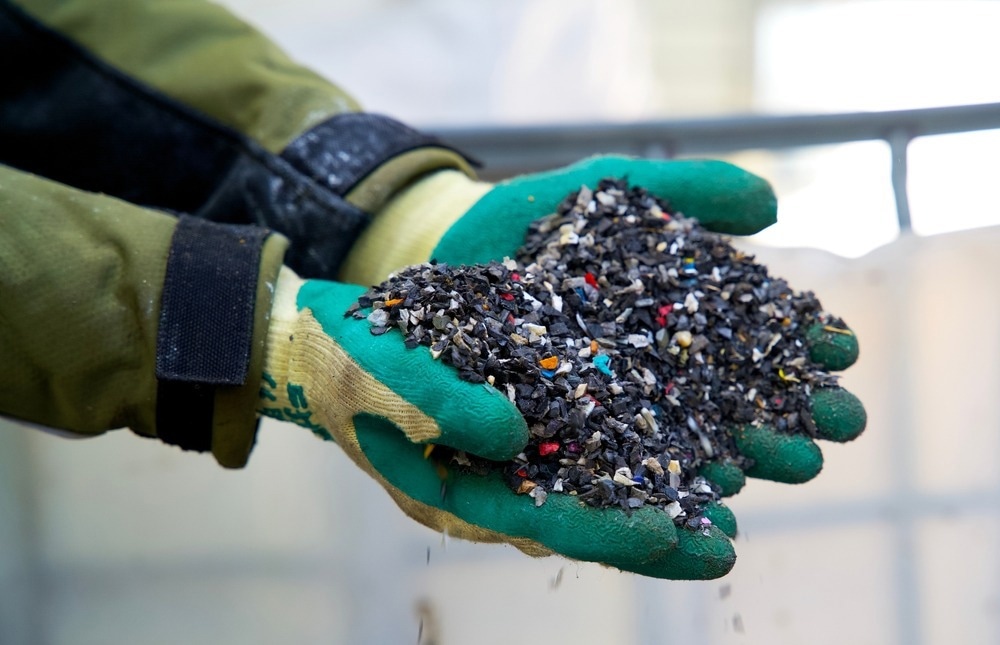Different polymer recycling methods, such as chemical recycling and mechanical recycling, can be used to manage plastic waste and minimize its impact on humans and the environment. Polymer recycling methods can also enable the creation of new products from polymer wastes in a rational, ecological, and economical way.

Image Credit: Rene Notenbomer/Shutterstock.com
Importance of Polymer Recycling
In the last few decades, the increased accumulation of polymer waste, specifically discarded/end-of-life plastics, in natural habitats and landfills across the world has severely affected both human health and the environment.
Toxic monomers in polymer wastes have caused reproductive problems and cancers. Additionally, different chemicals present in plastic waste, such as flame retardants, bisphenol A, and phthalates, have adversely affected animal and human health, specifically the endocrine system.
Thermoplastic polymers and thermosetting polymers are the major types of solid polymers. Thermoplastic polymers, such as high/low-density polyethylene (HDPE/LDPE), polyvinyl chloride (PVC), and polyethylene terephthalate (PET), can be softened or melted easily using heat for recycling.
Moreover, thermoplastics have secondary weak van der Waal interactions between polymer chains and covalent interactions between monomer molecules. These weak bonds can be broken by heat, leading to changes in the molecular structure. However, thermosetting plastics are non-recyclable due to the permanent chemical changes that occur during their formation.
Thermosetting plastics possess high dimensional and thermal stability, superior thermal and electrical insulating properties, and high rigidity due to the presence of highly cross-linked polymers that have a three-dimensional (3D) network of covalently bonded atoms.
The robust cross-linked structure demonstrates resistance to higher temperatures, resulting in greater thermal stability compared to thermoplastics. Thus, thermosetting plastics cannot be remolded, reformed, or recycled upon heating.
Polymer Recycling Methods
Polymer recycling methods can be classified into primary recycling, secondary recycling/mechanical recycling, tertiary recycling/chemical recycling, and quaternary recycling/energy recovery.
Primary Recycling
Primary recycling/re-extrusion is a closed-loop polymer recycling method using mechanical reprocessing. The polymers obtained using this method possess equivalent properties to virgin polymers. Primary recycling is used extensively to recycle process scrap within an industry.
However, primary recycling depends on the range of polymer grades in the plastic wastes, which is a major disadvantage. Thus, the method cannot be used to effectively recycle plastic products or packaging that consist of various polymers and other materials.
Secondary/Mechanical Recycling
Mechanical recycling/secondary recycling is an effective method for recycling conventional plastic waste materials into new raw materials without changing their basic structure. This method is the second most common polymer recycling method after energy recovery.
Mechanical recycling involves washing, separation, and preparation of plastic wastes to produce transparent, clean, high-quality, and homogenous end-products. However, mechanical recycling can only be performed in single polymer materials, such as polypropylene (PP), polyethylene (PE), and polystyrene (PS). Thus, the recycling of more contaminated and complex plastic waste is difficult using this method.
Tertiary/Chemical Recycling
Chemical/feedstock/tertiary recycling involves the recovery of the petrochemical constituents of a polymer through chemical cracking. Feedstock recycling is performed by decomposing plastic waste materials using chemical agents, heat, or other catalysts to convert the plastic waste into a hydrocarbon fuel or chemical.
Chemical recycling can be used to effectively treat highly contaminated and heterogeneous polymers and turn them into high-quality products, which makes this method a better alternative compared to mechanical recycling.
However, the application of chemical recycling is limited owing to economic concerns and technical reasons. Thus, the method is only used for specific polymer types, such as PET, polyamide (PA), and polyurethane (PU).
Additionally, multiple separation methods must be performed to recycle plastic waste materials completely using feedstock recycling. The separation methods include chemical depolymerization, catalytic cracking, hydrogenation, thermal treatment, and gasification.
Quaternary/Energy Recovery
Incineration/energy recovery/quaternary recycling implies burning plastic waste to produce energy in the form of electricity, steam, and heat. Plastic materials possess a very high calorific value as they are derived from crude oil.
The recoverable energy from plastic waste incineration depends on the type of plastic. Plastic waste incineration leads to a 90-99% volume reduction of the waste, which decreases the burden on the landfilling sites. However, the release of harmful substances into the atmosphere during waste processing is a major drawback of this method.
Best Polymer Recycling Methods
Although mechanical recycling of plastic waste is a more sustainable solution compared to other techniques, the method is not feasible for large-scale polymer recycling owing to its inability to recycle complex plastic waste. Chemical recycling and incineration/energy recovery are the best polymer recycling methods due to their advantages over mechanical recycling.
Chemical recycling can effectively treat all types of plastic wastes, including complex wastes, to produce high-quality end-products, while the incineration/energy recovery method can substantially reduce the organic material volume and produce energy in various forms from the waste.
More from AZoM: How are Bioplastics Made?
References and Further Reading
Mekhzoum, M. E. M., Benzeid, H., Rodrigue, D., Qaiss, A., Bouhfid, R. (2017). Recent Advances in Polymer Recycling: A Short Review. Current Organic Synthesis, 14, 171-185. https://www.researchgate.net/publication/314255254_Recent_Advances_in_Polymer_Recycling_A_Short_Review
Kulkarni, G. S. (2018). Introduction to Polymer and Their Recycling Techniques. Recycling of Polyurethane Foams, 1-16. https://doi.org/10.1016/B978-0-323-51133-9.00001-2
Grigore, M. E. (2017). Methods of Recycling, Properties and Applications of Recycled Thermoplastic Polymers. Recycling, 2(4), 24. https://doi.org/10.3390/recycling2040024
Disclaimer: The views expressed here are those of the author expressed in their private capacity and do not necessarily represent the views of AZoM.com Limited T/A AZoNetwork the owner and operator of this website. This disclaimer forms part of the Terms and conditions of use of this website.